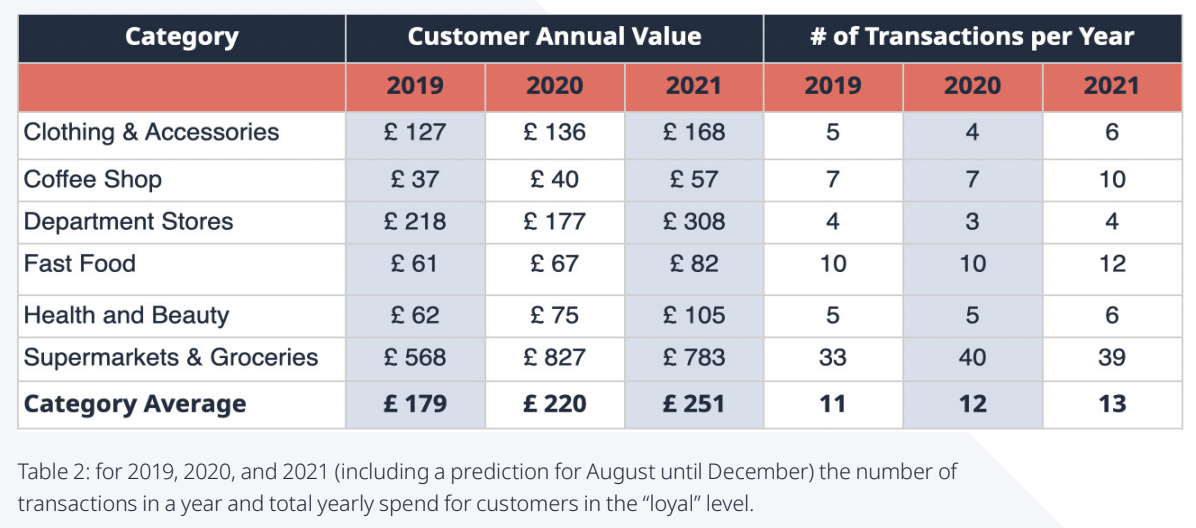Having identified that retailers are leaving money on the table when it comes to maximising their share of a customer’s wallet, we delved further into the customer loyalty levels to define a “tipping point of loyalty”.
It is difficult for retailers, without access to the insights obtained from Open Banking data, to know if a customer has the potential to be loyal, VIP, or VVIP. Upside’s point of loyalty provides a guide to the total number of purchases, or total spend, per year required to be a loyal customer. We define loyal customers as those spending 26% - 50% of their wallet with a specific retailer.
Whilst the tipping point of loyalty differs across categories, the overall number is 13 or £251 i.e. retailers need to get a customer to make 13 transactions per year or spend £251 in a year to ensure they fall into the “loyal” level.

On average, as the above table indicates, with every year it becomes more difficult to obtain a customer’s loyalty, as both the total number of transactions and spend per year required to be defined as “loyal” increases from 2019 to 2020.
We put this to our panel of retail experts for their perspective on the data. Tom Peace, Managing Director of The Loyalty People said that he agrees with the high level findings and stresses that the key to success for retailers is “to understand what the cognitive and behavioural notion is behind this tipping point occurring in customers”.
On average, as the above table indicates, with every year it becomes more difficult to obtain a customer’s loyalty, as both the total number of transactions and spend per year required to be defined as “loyal” increases from 2019 to 2020.
We put this to our panel of retail experts for their perspective on the data. Tom Peace, Managing Director of The Loyalty People said that he agrees with the high level findings and stresses that the key to success for retailers is “to understand what the cognitive and behavioural notion is behind this tipping point occurring in customers”.
Jonathan De Mello, Equity Retail Partner at CWM Retail Consulting, concurred, saying that “the research makes sense, and is in line with my experience and expectations”. He believes the key for retailers is “actionability”- “how can they then turn the knowledge of this tipping point into increased sales or improved profit”.
Customer Experience expert Martin Newman said “looking at the research into the ‘Upside tipping point’, the results don’t surprise me at all. Although 13 is found to be the average number of times a customer needs to shop with a retailer to become loyal, it is possible for customers to become loyal after just one visit if they had an exceptional experience”. Martin Newman raises a good point about the quality of the experience that retailers are able to provide, but also the importance of retail brands as a signifier of trust. Customers can become loyal to particular brands, and this creates a greater level of loyalty beyond the traditional marketing paradigms of product, price, place and promotion.
Retail expert and former Director of CRM Loyalty and Clienteling at BT, Tanya Bowen said “the average point of loyalty established by Upside does feel right for industries like fashion and footwear”. However, she noted that at other customer facing organisations she has worked at before they have used different cohorts to understand their customers, saying, “it’s important to recognise and understand the upper levels of loyal customers, the top 25%, top 10%, and of course outliers that represent the top 2% of your profit. Data like this research from Upside can help articulate the value of VVIP’s to businesses’.’
Pete Markey, CMO at Boots UK agreed that the figures for 2021 in Health & Beauty match his expectations. He added, “The key is having compelling and consistent conversations with customers. You’ve got to think beyond the initial sale.” Pete also noted that the increase in the tipping point of loyalty is interesting, and that it does make sense when taking into account factors such as more competition and the move to digital or online shopping. He expanded, “This just reiterates how important it is to ensure there is ease of shopping and convenience. Customers will stick to the sites that are usable and easy to use.”
Henry Lane Fox, CEO at Founders Factory, describes the ability to get this level of customer insight from actual spend data as a “game changer”. He expanded, saying ”understanding not only Customer Lifetime Value per customer, but the size of their wallet in any given category, changes how much firms invest to acquire customers, how much they invest to keep them, and helps the sector understand whether there is upsell or cross sell capacity.
If you would like to read more about our insights on customer loyalty, read our white paper ‘The Tipping Point of Loyalty’.

